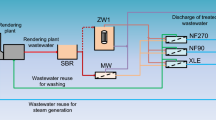Abstract
The corn based dry grind process is the most widely used method in the US for fuel ethanol production. Fermentation of corn to ethanol produces whole stillage after ethanol is removed by distillation. It is centrifuged to separate thin stillage from wet grains. Thin stillage contains 5–10% solids. To concentrate solids of thin stillage, it requires evaporation of large amounts of water and maintenance of evaporators. Evaporator maintenance requires excess evaporator capacity at the facility, increasing capital expenses, requiring plant slowdowns or shut downs and results in revenue losses. Membrane filtration is one method that could lead to improved value of thin stillage and may offer an alternative to evaporation. Fractionation of thin stillage using ultrafiltration was conducted to evaluate membranes as an alternative to evaporators in the ethanol industry. Two regenerated cellulose membranes with molecular weight cut offs of 10 and 100 kDa were evaluated. Total solids (suspended and soluble) contents recovered through membrane separation process were similar to those from commercial evaporators. Permeate flux decline of thin stillage using a resistance in series model was determined. Each of the four components of total resistance was evaluated experimentally. Effects of operating variables such as transmembrane pressure and temperature on permeate flux rate and resistances were determined and optimum conditions for maximum flux rates were evaluated. Model equations were developed to evaluate the resistance components that are responsible for fouling and to predict total flux decline with respect to time. Modeling results were in agreement with experimental results (R 2 > 0.98).













Similar content being viewed by others
References
RFA (2007) Industry statistics http://www.ethanolrfa.org/industry/statistics/#EIO. Renewable fuels association: Washington, DC. Accessed 20 Sept 2007
Wall JS, Bothast RJ, Lagoda AA, Kenneth RS, Wu YV (1983) Effects of recycling distillers solubles on alcohol and feed production from corn fermentation. J Agric Food Chem 31:770–775
Rausch KD (2002) Front end to backpipe: membrane technology in the starch processing industry. Starch/Starke 54:273–284
Wu YV, Sexson KR, Wall JS (1983) Reverse osmosis of soluble fraction of corn stillage. Cereal Chem 60:248–251
Agbisit RM, Singh V, Valenti JJ, Kakleas M, Tumbleson ME, Rausch KD (2003) Technique to measure surface-fouling tendencies of steepwater from corn wet milling. Cereal Chem 80:84–86
Thompson CI, Rausch KD, Belyea RL, Tumbleson ME (2005) Microfiltration of gluten processing streams from corn wet milling. Bioresour Technol 97:348–354
Templin TL, Johnston DB, Singh V, Tumbleson ME, Belyea RL, Rausch KD (2006) Membrane separation of solids from corn processing streams. Bioresour Technol 97:1536–1545
Wang Y, Wang T, Su Y, Peng F, Wu H, Jiang Z (2005) Remarkable reduction of irreversible fouling and improvement of permeation properties of polyethersulfone ultrafiltration membrane by blending with Pluronic F127. Langmuir 21:11856–11862
Pieracci J, Crivello J, Belfort G (2002) Increasing membrane permeability of UV-modified poly(ether sulfone) ultrafiltration membranes. J Memb Sci 202:1–16
Ko MK, Pellegrino JJ (1992) Determination of osmotic pressure and fouling resistances and their effects on performance of ultrafiltration membranes. J Memb Sci 74:141–157
Wiesner MR, Chellam S (1992) Mass transport considerations for pressure-driven membrane processes. J Am Water Works Assoc 84:88–95
Ramesh Babu P, Gaikar VG (2001) Membrane characteristics as determinant in fouling of UF membranes. Sep Purific Technol 24:23–34
Choi H, Zhang K, Dionysiou DD, Oerther DB, Sorial GA (2005) Effect of permeate flux and tangential flow on membrane fouling for wastewater treatment. Sep Purific Technol 45:68–78
Jiraratananon R, Chanachai A (1996) A study of fouling in the ultrafiltration of passion fruit juice. J Memb Sci 111:39–48
de Barros STD, Andrade CMG, Mendes ES, Peres L (2003) Study of fouling mechanism in pineapple juice clarification by ultrafiltration. J Memb Sci 215:213–224
Vladisavljevi’c GT, Vukosavljevi’c P, Bukvi’c B (2003) Permeate flux and fouling resistance in ultrafiltration of depectinized apple juice using ceramic membrane. J Food Eng 60:241–247
Rai P, Rai C, Majumdar GC, DasGupta S, De S (2006) Resistance in series model for ultrafiltration of mosambi (Citrus sinesis (L) Osbeck) juice in a stirred continuous mode. J Memb Sci 283:116–122
Satyanarayana SV, Bhattacharya PK, De S (2000) Flux decline during ultrafiltration of kraft black liquor using different flow modules: a comparative study. Sep Purific Technol 20:155–167
Li M, Zhao Y, Xing W, Wong FS (2007) Resistance analysis for ceramic membrane microfiltration of raw soy sauce. J Memb Sci 299:122–129
Bhattacharya PK, Agarwal S, De S, Rama Gopal UVS (2000) Ultrafiltration of sugarcane juice for recovery of sugar: analysis of flux and retention. Sep Purific Technol 21:247–259
Lapisova K, Vlcek R, Klozova J, Rychtera M, Melzoch (2006) Separation techniques for distillery stillage treatment. Czech J Food Sci 24:261–267
American Association of Cereal Chemists International, Approved Methods of the AACC, 10th ed Method 44–15A, 44-19 (2000) The Association: St Paul, MN
Wang P, Singh V, Xu L, Johnston DB, Rausch KD, Tumbleson ME (2005) Comparison of enzymatic (E-mill) and conventional dry-grind corn processes using a granular starch hydrolyzing enzyme. Cereal Chem 82:420–424
AOAC, official methods of the AOAC, 17th ed Methods 92039, 94205, 99003 The Association of Official Analytical Chemists (2003) Gaithersburg, MD
Do DD, Elhassadi AA (1985) A theory of limiting flux in a stirred batch cell. J Memb Sci 25:113–132
Zeman LJ, Zydney AL (1996) Microfiltration and ultrafiltration: principles and applications. Marcel Dekker, New York
Ghosh R (2003) Protein bioseparation using ultrafiltration: theory applications and new developments. Imperial College Press, London
Bhattacharjee S, Bhattacharya PK (1992) Flux decline with low molecular weight solutes during ultrafiltration in an unstirred batch cell. J Memb Sci 72:149–161
Acknowledgments
We thank Larry Pruiett for his technical assistance. The Illinois Council for Food and Agricultural Research (C-FAR) provided partial funding through the External Competitive Grants Program (project IDA CF07I-012-1-SEN). Partially funded through a Specific Cooperative Agreement (SCA 58-3620-2-149) with the National Center for Agricultural Utilization Research, Agriculture Research Service, USDA, Peoria, IL.
Author information
Authors and Affiliations
Corresponding author
Rights and permissions
About this article
Cite this article
Arora, A., Dien, B.S., Belyea, R.L. et al. Thin stillage fractionation using ultrafiltration: resistance in series model. Bioprocess Biosyst Eng 32, 225–233 (2009). https://doi.org/10.1007/s00449-008-0240-6
Received:
Accepted:
Published:
Issue Date:
DOI: https://doi.org/10.1007/s00449-008-0240-6




